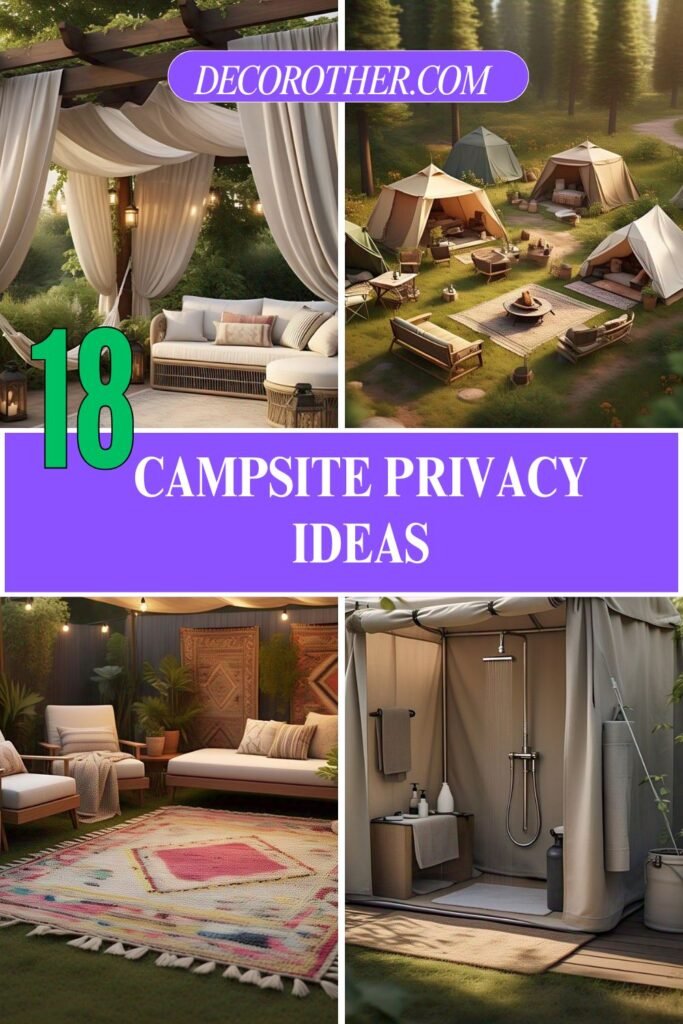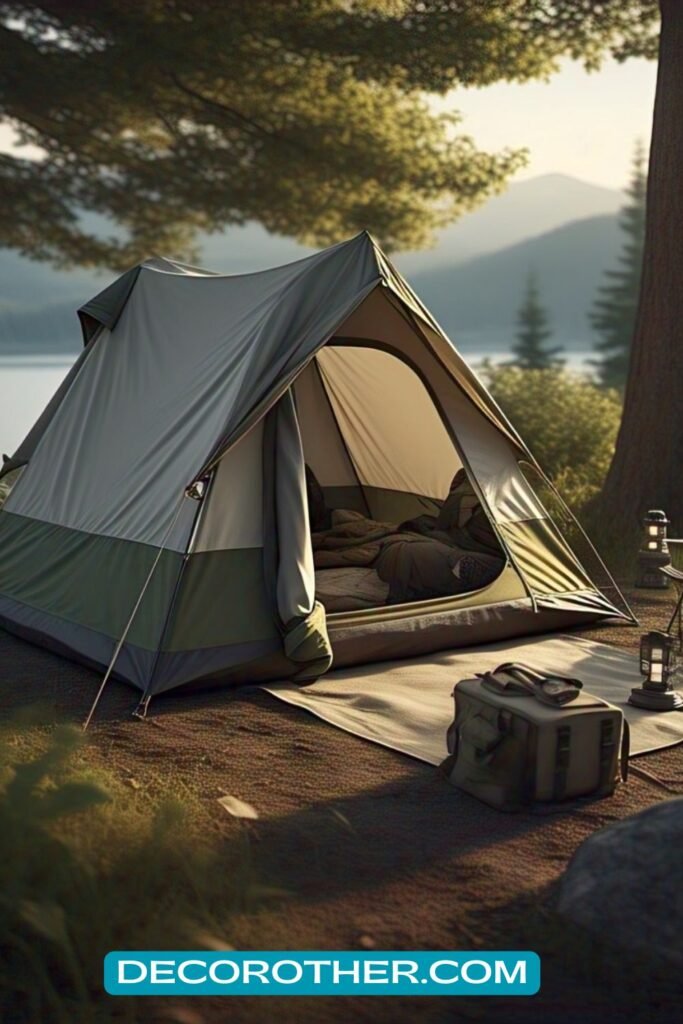When you’re camping, privacy can sometimes feel like a luxury that’s hard to come by. Whether you’re camping in a crowded campground or setting up in the wilderness, having a bit of privacy can make a huge difference in your comfort and overall enjoyment. Whether you’re camping solo, with family, or with friends, these 18 campsite privacy ideas will help you create a secluded, peaceful environment.

1. Privacy Tents for Changing

One of the easiest ways to create privacy at your campsite is by using a privacy tent. These portable enclosures can serve multiple purposes, from changing clothes to using the restroom. Look for lightweight, quick-to-assemble privacy tents that fold up easily for convenient storage.
Why It Works:
Privacy tents create a personal space that’s perfect for changing, showering, or just escaping for a while. They are available in a variety of sizes and materials, ensuring you find the one that best suits your needs.
2. Use Tarps for Extra Coverage

Tarps are affordable, easy to use, and incredibly versatile. You can set them up around your tent or campsite to create temporary walls or canopies. Secure them with ropes or stakes to form a barrier between your campsite and the rest of the area.
Why It Works:
Tarps can shield your campsite from the view of other campers and provide a makeshift privacy fence. Plus, they offer protection against the elements, like wind and rain.
3. Create Natural Barriers with Shrubs or Trees
When camping in a more natural setting, you can use existing trees, shrubs, and bushes to build your privacy barriers. Planting or positioning your tent near dense vegetation can naturally block sight lines from other campers.
Why It Works:
Nature’s barriers offer a high level of privacy and blend seamlessly with the environment. Plus, you’ll enjoy the extra shade and natural aesthetics they provide.
4. Strategically Position Your Tent

When setting up your campsite, consider the layout of your surroundings. If you’re camping in a public campground, try to pitch your tent in a way that takes advantage of natural features like hills, trees, or rock formations. Face your tent opening away from high-traffic areas.
Why It Works:
Positioning your tent with thoughtful consideration of natural features ensures that you minimize the risk of being overlooked by other campers.
5. Invest in Privacy Curtains for Your Tent

Privacy curtains are a simple yet effective solution for adding seclusion to your tent. Many tents come with built-in privacy features, but you can also purchase separate curtain kits to add to your setup.
Why It Works:
Privacy curtains block external views, allowing you to relax and move around inside your tent without feeling exposed. They also help reduce the amount of light inside, making it easier to sleep.
6. Use Outdoor Rugs for Personal Space

If you’re camping in a popular area, it can feel like everyone is constantly walking by your campsite. Lay down an outdoor rug to help define your space and create a barrier between your site and others.
Why It Works:
Outdoor rugs add both a visual and physical barrier to help set boundaries. They make your campsite feel more like a home and can discourage people from walking too close.
7. Install a Campfire Barrier

If you’re camping near other groups, a campfire can often be a communal area. Set up a simple barrier around your campfire with stone, logs, or other materials to create a more private and intimate setting.
Why It Works:
Creating a designated campfire zone provides both privacy and a sense of space, helping you and your group enjoy the warmth and light without interruptions from others.
8. Use Privacy Screens

A privacy screen is a freestanding, portable barrier that you can set up around your campsite. These screens come in various designs, including fabric, wood, or bamboo, and can be easily moved and adjusted.
Why It Works:
Privacy screens offer a versatile, non-permanent solution for creating a secluded space. They’re perfect for situations where you need a quick privacy fix.
9. Create a Tent Village

If you’re camping with a group, consider setting up a “tent village” where each person or family has their own tent but is separated by privacy barriers like trees or tarps. This creates individual spaces while still allowing you to be close together.
Why It Works:
A tent village offers privacy for each person or group while keeping the sense of community alive. This is especially helpful for larger groups with varying privacy needs.
10. Add a Canopy or Gazebo

Gazebos and canopies can be a great addition to your campsite if you need additional shade or privacy. They can be set up as a central gathering space while still providing coverage and reducing exposure to the outside world.
Why It Works:
A canopy or gazebo helps establish a sense of privacy by shielding you from the view of other campers and providing shelter from the elements.
11. Create a Backdrop with Curtains or Screens

If you’re looking to block the view from your tent’s entrance, install curtains or folding screens. These can be tied back when you want an open space and drawn shut when you need privacy.
Why It Works:
Curtains or screens provide an easy and adjustable way to shield your tent from prying eyes. Plus, they help control the amount of light inside, making it easier to relax.
12. Set Up a Shower Tent

For privacy while bathing, use a shower tent. These compact enclosures are specifically designed to provide privacy for showers or quick clean-ups. They can also double as changing rooms.
Why It Works:
Shower tents are easy to set up and provide a space where you can feel comfortable even in more crowded campsites.
13. Build a Privacy Fence with Driftwood
If you’re camping near a beach or lake, you can build a DIY privacy fence out of driftwood or other natural materials. Stack them to form a rustic, effective barrier around your campsite.
Why It Works:
This idea not only helps you maintain privacy but also adds an eco-friendly and creative touch to your campsite setup. Plus, it allows you to make use of natural, free resources.
14. Use Mesh Sides for Tent Ventilation and Privacy

When camping in warm weather, you want privacy without sacrificing ventilation. Many tents have mesh sides that offer both privacy and airflow. You can use curtains or blankets over mesh areas for added seclusion.
Why It Works:
Mesh sides are breathable but can still provide privacy when necessary. Layering your tent with a combination of mesh and fabric can help maintain a balance between privacy and comfort.
15. Use Your Car for Added Privacy

Sometimes, your vehicle can double as a privacy shield. Park it strategically to block the view of your campsite from other campers. This is especially useful if you’re camping in a less secluded area.
Why It Works:
Your car can act as a buffer between you and other campers, offering privacy without the need to add more structures to your campsite.
16. Camp in Secluded Areas

If privacy is a top priority, consider camping in more remote or secluded areas. Look for campgrounds or national forests that offer dispersed camping, where you can choose your spot and avoid the crowd.
Why It Works:
Choosing a more secluded campsite naturally offers more privacy and a quieter, more peaceful environment.
17. Hang Outdoor Curtains or Fabrics

If you don’t have privacy walls for your tent or campsite, consider hanging outdoor curtains or fabrics from a nearby tree or support structure. This creates a temporary privacy barrier that can be adjusted as needed.
Why It Works:
Outdoor curtains are easy to install and remove, offering you a flexible, customizable privacy solution for your campsite.
18. Use a Tent with an Attached Vestibule

A vestibule is a small, sheltered area at the entrance of your tent. Many modern tents come with a vestibule that you can use to store gear or even change clothes without feeling exposed.
Why It Works:
A vestibule adds an extra layer of privacy to your tent and makes your camping experience more organized by keeping gear out of sight.
Conclusion: Enjoy Your Camping Experience with Privacy
Maintaining privacy while camping doesn’t have to be a challenge. With these 18 campsite privacy ideas, you can enjoy your time outdoors without feeling exposed or uncomfortable. Whether you’re in a busy campground or exploring a more remote area, these tips will help you create a peaceful, private space to relax, unwind, and truly enjoy nature.
